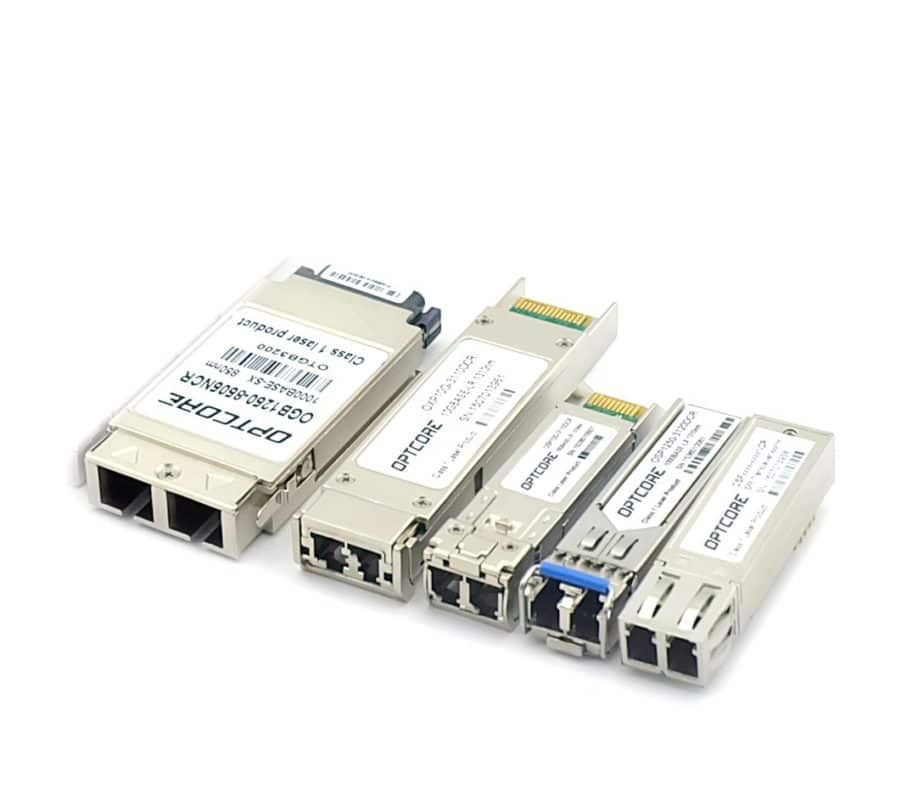Optical Transceiver
GBIC vs SFP vs SFP+ vs XFP, what is the difference?
GBIC, SFP, SFP+, and XFP are all terms for transceiver optics that plug into a particular port on a switch, router, or other network device to convert the port to a copper or fiber interface. The commonly used SFP, SFP+, and XFP all have an LC connector. SFP and SFP+ have an identical pinout that is different from XFP optics. SFP+ and XFP have the DDM function as a default, whereas SFP partly supports the DDM function.
Comparison: SFP vs GBIC vs SFP+ vs XFP
| Optics Type | Standard | Data Rate | Wavelength | Fiber Type | Max Distance | Typical Connector | DOM | Operating Temperature |
| SFP | SFP MSA | 155Mbps 622Mbps 1.25Gbps 2.125Gbps 2.5Gbps 3Gbps 4.25Gbps | 850nm 1310nm 1550nm CWDM DWDM BIDI | OM1 OM2 OS1 OS2 | 160km | LC SC RJ-45 | No or Yes | Commercial Industrial |
| GBIC | GBIC MSA | 155Mbps 622Mbps 1.25Gbps | 850nm 1310nm 1550nm CWDM DWDM BIDI | OM1 OM2 OS1 OS2 | 120km | SC RJ-45 | No | Commercial Industrial |
| SFP+ | IEE802.3ae SFF-8431 SFF-8432 | 6Gbps 8.5Gbps 10Gbps | 850nm 1310nm 1550nm CWDM DWDM BIDI Tunable Copper | OM3 OM4 OS1 OS2 | 120km | LC | Yes | Commercial Industrial |
| XFP | IEE802.3ae XFP MSA | 6Gbps 8.5Gbps 10Gbps | 850nm 1310nm 1550nm CWDM DWDM BIDI Tunable Copper | OM3 OM4 OS1 OS2 | 120km | LC | Yes | Commercial Industrial |
Figure 1 A Typical SFP vs SFP+ vs XFP Module
SFP vs SFP+ (SFP Plus), What is the difference?
SFP and SFP+ have a similar form factor dimension; hence, they look identical. SFP optics usually support 155Mb/s, 1.25Gb/s to 4.25Gb/s, while SFP+ ones support data rates up to 8.5Gb/s and 10Gb/s.
SFP is for Fast Ethernet, Gigabit Ethernet,1x/2x/4x Fiber Channel, and SDH/SONET with data rate below 2.488Gb/s applications.
SFP+ for 10 Gigabit Ethernet, 10G SDH/SONET applications. SFP is compliant with IEEE802.3, INF-8074, and SFF-8472, while SFP+ is compliant with the protocol of IEEE 802.3ae, SFF-8431, and SFF-8432.
XFP vs SFP+, What is the difference?
XFP is a separate standard that also supports 10Gb/s speeds for applications such as 10 Gigabit Ethernet, 10 Gbit /s Fibre Channel, Synchronous optical networking (SONET) at OC-192 rates, Synchronous optical networking STM-64, 10 Gbit /s Optical Transport Network (OTN) OTU-2.
The primary difference between SFP+ and the slightly older XFP standard is that SFP+ without the chip for clock and data recovery is smaller than an XFP, enabling greater port density.
However, some SFP+ optics manufacturers, like Optcore, have developed SFP+ with CDR for special applications. XFP is defined by the XFP Multi-Source Agreement, which is different from the SFP+ MSA. Since SFP+ has a smaller dimension than XFP, which provides a higher port density in switches and routers, it is becoming increasingly popular.

 Español
Español









Do all SFP models require APC fiber jumpers?
No, we sure most the SFP require PC or UPC fiber jumpers.